ARTICLE AD BOX
Design
The Ninja slushi uses a condenser and an auger to cool and mix ingredients, chilling them to the point of freezing but stopping it from freezing solid. This machine has a great capacity, with a 475ml minimum and an 1890ml maximum, so it tops out at around six servings, depending on what you’re making.
The payoff for this capacity, however, is the size. The slushi takes up a huge amount of room. In fairness, I’m testing this in a London flat, so space is already tight, but it takes up at least a fifth of my total counter space. I’ve had to move my air fryer and kettle to clear enough room for this, and storing it will be tricky.
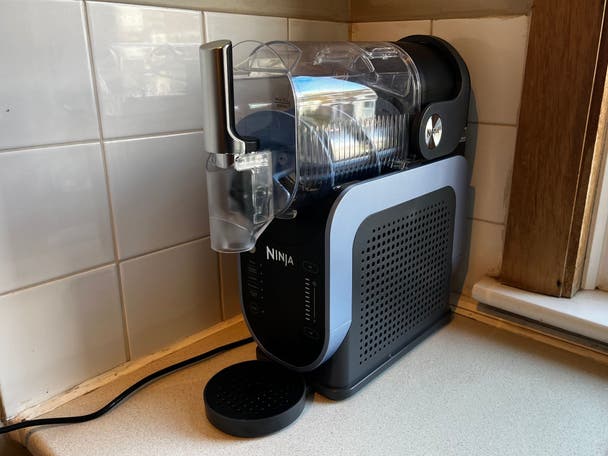 This appliance takes up a lot of room (Alex Aitcheson-David)
This appliance takes up a lot of room (Alex Aitcheson-David)During the current hot weather, I’m happy to keep it on the counter, but when the winter inevitably rolls around, I’ll have to come up with a clever place to keep it – I’ve measured and it won’t fit in any of my standard-size kitchen cupboards.
However, it’s very quiet. Though rated for 55dB, when I measured it was never louder than 45dB. It’s a similar sound to a washing machine or dishwasher; a gentle whirr with occasional sloshing liquid. The machine beeps when it’s done, too, which is a useful feature when you’re in another room.
The only noise issue is that it runs constantly, even once it’s finished – but the slush mix would freeze solid if it didn’t. The low-level noise will be fine if you keep this in the kitchen while entertaining in the garden, but if you live in a flat, you might find the noise too much for dinner parties.
It’s easy to clean, and though I tested some pretty messy ingredients, there was no trace of Oreos, hot sauce, or tomato juice after a quick hand wash.
Slush function
The most obvious test is on the straightforward slush function. I filled the tank with 700ml of Coca-Cola and set it to run. The guide says it will take around 15 minutes; it took 17, which is slower than stated, but not by much.
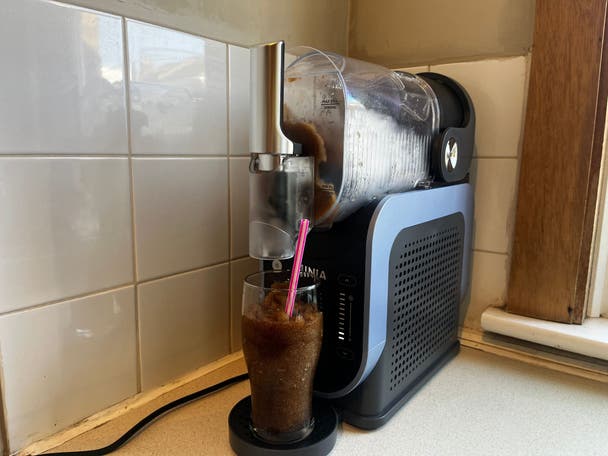 A slushy like this is perfect for a heatwave (Alex Aitcheson-David)
A slushy like this is perfect for a heatwave (Alex Aitcheson-David)The result was impressive. The machine made a perfect Coca-Cola slushie. You have to mix it a little when it comes out of the machine, but it tasted incredible, particularly on a hot day. The sugar-sensitive might find it a little syrupy, but that’s because, like any slushie, the freezing process gets rid of the carbonation.
It would be amazing for Coca-Cola floats, a great base for cocktails, and work particularly well with flavoured sodas. Just bear in mind that this machine needs sugar to work, so diet fizzy drinks can’t be turned into slush.
Frozen juice
It was a similar story on the frozen juice function. I used 700ml of tropical juice, hit the frozen juice function and let it run. The guide said it would need about 15 minutes, but it took 19.
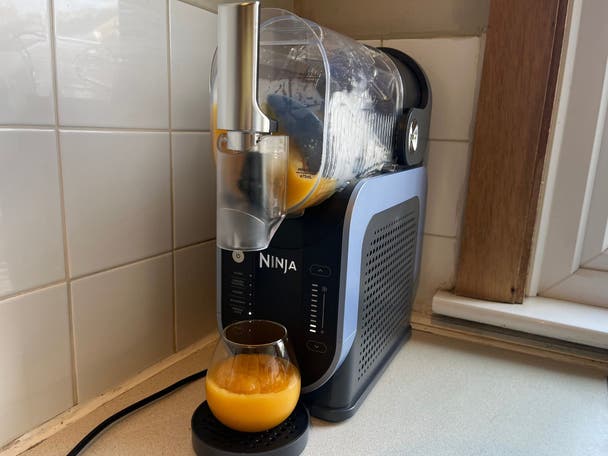 This juice was almost perfect, it just needed a mix (Alex Aitcheson-David)
This juice was almost perfect, it just needed a mix (Alex Aitcheson-David)The result was delicious. Like the Coca-Cola, it needed a little mixing in the glass, but it tasted great. It was very cold and perfect for a hot day. It’s a slightly healthier option than Coca-Cola, but not by much – the machine always needs 5g of sugar per 100ml, because the sugar content works like antifreeze, stopping the liquid from freezing solid.
Milkshake
Next up: the milkshake function. I wanted to see how it handled trickier ingredients, including those with a little grit, so I decided to make an Oreo shake out of chocolate milk, double cream, Oreos and a little vanilla extract.
I had to smash some Oreos to mix them with the chocolate milk – otherwise, they’d never fit through the feeder hole. Even with a lot of smashing, I still had to help them through with chopsticks, and it meant that not all of the cream went through the feeder hole. The “easy-fill port” has a small ledge to slowly add liquids, but I found that heavier ingredients like cream don’t flow straight into the machine.
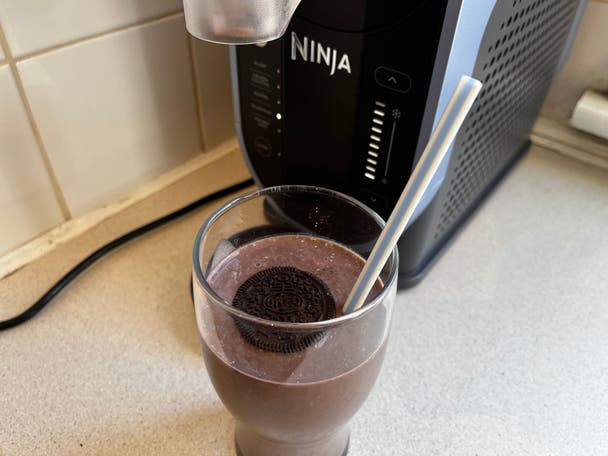 An Oreo milkshake was delicious, but a little pointless (Alex Aitcheson-David)
An Oreo milkshake was delicious, but a little pointless (Alex Aitcheson-David)It beeped after 15 minutes, about as long as predicted in the guide. However, the milk meant that it didn’t really thicken, despite all the extra sugar from the Oreos. This is a little odd because this is the sugariest drink I tested; I’ve done the maths and it worked out at about 32.3g of sugar per serving. I turned the level up two points for five minutes, and not much changed, so in the end I turned up to one below max for another 10.
The result was a delicious, thick milkshake. The machine handled the gritty Oreo crumbs well, and the auger meant they were so well-mixed that you couldn’t see them in the final product. It tasted great, but I think this is the least impressive function of this machine. It’s perfectly nice, but it’s not dissimilar from making one of these in a milkshake machine or blender, and it takes a lot longer.
Frappé
I then tried out the frappé function with Ninja’s recipe: 350ml chilled coffee, 350ml whole milk, a tablespoon of double cream and 60 grams of sugar. That’s not a typo – it really needs that much sugar.
It’s quite an involved recipe, so this isn’t an everyday drink. It’s not exactly hard to make, but you have to make and then chill the coffee, then mix the sugar in with the milk so that you can pour it into the machine. It’s no surprise then that it took the longest of all the recipes I tried. The booklet suggested 15 minutes, but it took half an hour. In short, don’t buy one of these thinking you can make a quick frappe before work.
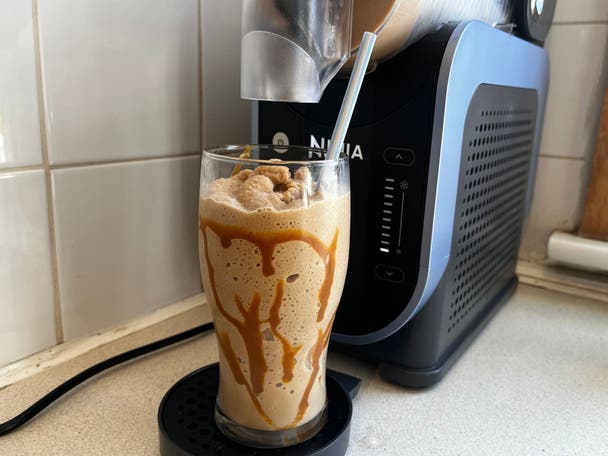 A frappe made in the Ninja Slushi (Alex Aitcheson-David)
A frappe made in the Ninja Slushi (Alex Aitcheson-David)However, it made for one of the most delicious frappes I’ve ever had. The slush is refreshing and cool on a summer’s day, and making it at home makes for better quality than a high street coffee shop frappe. The big issue here is the sugar content – 60 grams of sugar for two portions is hefty. I’m not a huge fan of sweet coffee, but even if I were, 30 grams of sugar per 350ml serving is a lot of sugar. Anyone worried about their sugar intake should probably steer clear of this machine.
Frozen cocktail
The best test of a slushy machine is whether or not it can handle a frozen margarita – it’s half the reason slushy machines were invented. (Note to my editor: I tested this after work. I promise I’m not writing this review with the aid of 2l of frozen tequila).
To assess the frozen cocktail function, I first tried a margarita mixer with some tequila. It was easy to pour everything in and set the machine running. The guide said it needed 30 minutes, but it was finished in 17. However, the first attempt was a failure, though it wasn’t the machine’s fault. My ratios were off; the mixer had too little sugar and the tequila had too much alcohol for the liquid to turn to slush. It tasted incredible and was right on the point of being a proper slushy, but it wasn’t quite right.
I made a second attempt with a ready-made margarita and tequila mix, keeping an eye on it as it developed. I wanted to use a ready-made mix when testing cocktails because that’s how most people will use this machine. Assembling all the parts for a full-on margarita is pretty pricey, especially at the quantities you need to use for this machine.
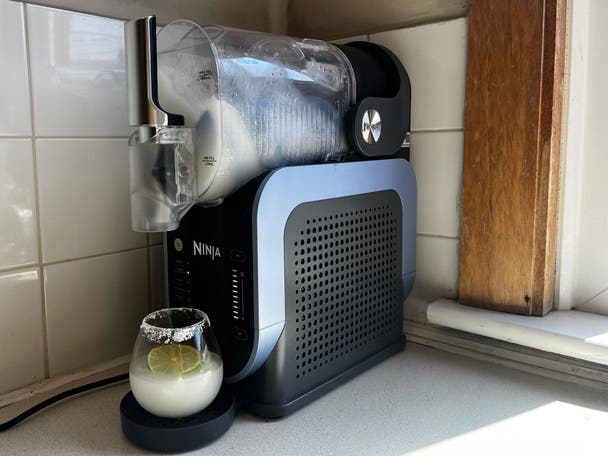 This margarita was dangerously delicious (Alex Aitcheson-David)
This margarita was dangerously delicious (Alex Aitcheson-David)Again, it was done early, and again, the mix wasn’t quite right, so I added some cloudy lemonade and lime to boost the sugar levels. Even this didn’t work. I had to dilute it with water to take out some alcohol, per Ninja’s troubleshooting guide and even ended up reaching up the back of my cocktail cupboard for some long-forgotten agave nectar to give this enough sugar to gum up into slush.
Once I’d nailed it, however, it was incredible. It was a textbook margarita, delivering a perfect hit of sweet and sour citrus, served ice-cold. It’s one of the best drinks I’ve ever made, and with a little work, it could be a go-to in my cocktail arsenal. However, it’s a bit frustrating that it needed so much tweaking.
It’s partly user error, but ‘frozen cocktail’ is such a broad function that it’s hard to know what will work. The frozen cocktail function will be great for rum and cokes, but more involved cocktails need a little finessing.
Michelada
Finally, I made one of my favourite summer drinks, a michelada. For the uninitiated, it’s a mix of beer, tomato juice, Worcester sauce and hot sauce – a bit like a Bloody Mary with beer instead of vodka. I wanted to try the machine without presets, and I also wanted to test how easy it was to clean. Any trace of hot sauce left over in the machine would ruin any future slushies.
I added my ingredients and spotted a tiny design issue. Adding a dash of anything – in this case, some Maggi liquid seasoning – is tricky because of the “easy-fill port”. It’s not just a hole in the top of the machine, but a slope down to a tiny inlet hole that slowly drips liquid into the machine. However, thicker liquids like these sit on the slope and don’t entirely fall into the vessel.
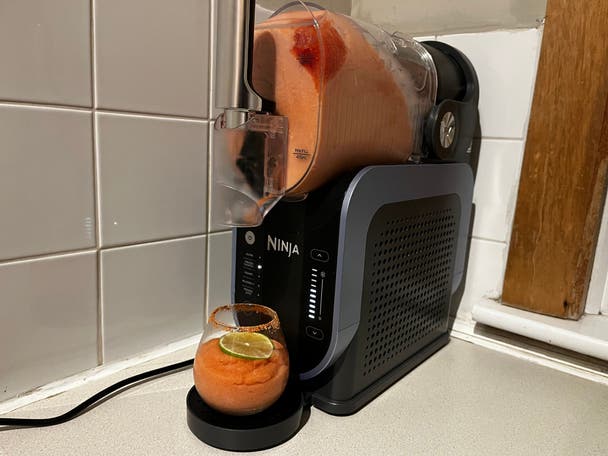 A michelada made in the Ninja Slushi (Alex Aitcheson-David)
A michelada made in the Ninja Slushi (Alex Aitcheson-David)One other small issue here is that there was one spot in the top right corner of the machine where the drink wasn’t mixed properly, but it sorted itself out once I took some slush out. However, these are pedantic points. The drink itself was, once again, incredible. It made a delicious michelada slush that’s somehow even more refreshing than usual. I think it would be a huge hit at a summer barbecue.
Price
The big drawback with this appliance, however, is the price. At £349, it is expensive – you could nearly get a Nintendo Switch 2 for the same price.
In fairness, this is a nearly unique appliance. While there are lots of ice cream makers on the market, slush machines are much rarer in the UK. There are lots of plastic single-serve slush makers for kids, like this Chill Factor slushy maker (£10, Argos.co.uk), but these only make one portion. If you’ve ever tried to use one, you’ll know that they don’t really work, making for a slightly runny drink, and you also need to freeze the cup ahead of time. If you want slushy drinks at home, the Ninja slushi is by far your best bet.
However, it’s much more expensive than equivalent ice cream makers. For example, I know first-hand that the Cuisinart Deluxe ice cream maker (£99, Amazon.co.uk) makes good ice cream for hundreds less than this slushi. However, that’s not exactly comparing like with like. The slushi does things ice cream makers can’t. Ice cream makers usually need to freeze the bowl ahead of time, but this machine makes slushy drinks with very little prep. Until another brand makes a good domestic slushy maker, this is really the only option on the market.



(1).jpeg?width=1200&height=800&crop=1200:800)





 English (US) ·
English (US) ·